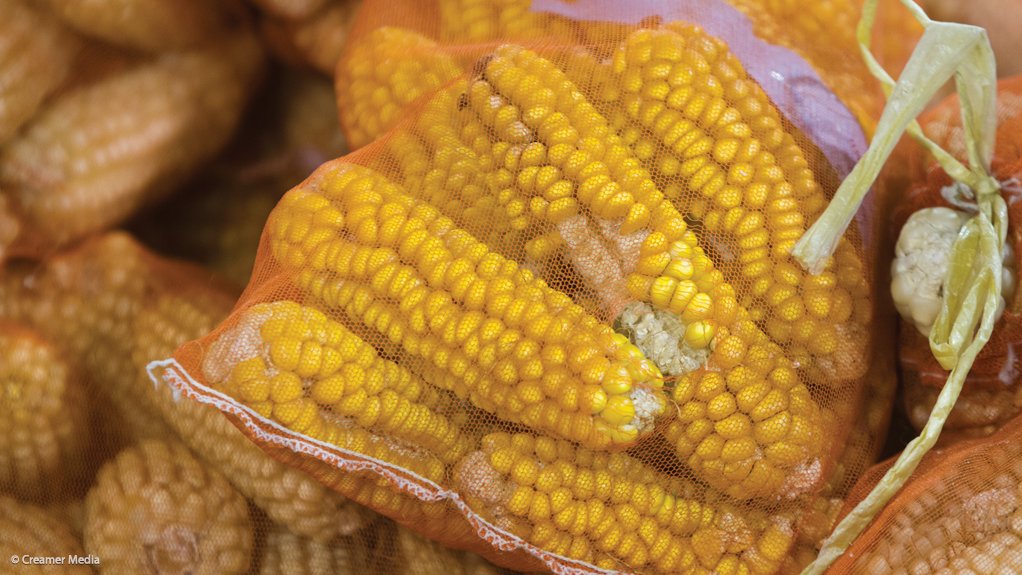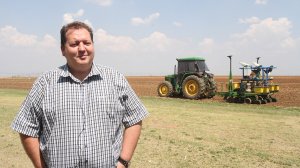Monsanto says GMOs will meet future food demands


Engineering News talks to Monsanto South Africa MD Kobus Steenkamp about the company's role in ensuring food security through biotechnology traits, organic farming and obstacles in Africa at Monsanto's Petit Research Farm, in Benoni. Camerawork and editing Nicholas Boyd
Photo by Duane Daws
Although honourable, Monsanto South Africa MD Kobus Steenkamp does not see organic farming reaching a stage where it will provide 100% food security, highlighting the ability of genetically modified organisms (GMOs) to increase the yield of every hectare.
“Our main focus is on increasing productivity on every hectare available. Organic farming needs more land, because its yield is less. There are various benefits of organic farming, but we don’t have the luxury of all the land [required],” he said on Wednesday at a site tour of the agriculture company’s Petit Research Farm, in Petit, Benoni.
There was limited land available owing to more and more land being allocated to development. Highlighting the loss of Midrand, previously some of the top productive arable land in South Africa, Steenkamp pointed out that farmers would need to produce enough food with fewer resources to support the world’s increasing population, adding that tens of thousands of hectares were lost every year to modernisation.
GMO would also aid the protection of South Africa’s biodiversity, said Steenkamp, explaining that it would be unfortunate if farmers took up cattle farming in the Kruger National Park because the country had run out of pasture land. “That would be something very detrimental to South Africa’s biodiversity and is something that we should not even consider. [As such], we need to have technologies in place to ensure that we can produce the food needed on the land we have available.
“I am not saying there isn’t a place for organic farming. Unfortunately, the same does not apply to the promoters of organic farming because they believe they have the only solution,” he noted. GMO products had also undergone extensive testing, Steenkamp added, confirming that GMO food has the same nutritional value as any other food stuff.
Other factors threatening food security included the rise in the global population from 4.4-billion in 1980 to 7.1-billion today, with this number expected to grow to more than 9.6-billion by 2050. “The concerning factor is that this growth is not happening in Europe or America, it’s happening in the developing countries such as India, China and those in Africa, [where issues around food security already exist],” Steenkamp stressed, adding that more people were also moving to cities to improve their economic situation.
As such, changing economies and diets were also impacting maize consumption as a growing global middle-class was choosing animal protein as a larger part of their diet. Therefore, more grain was needed to produce these protein products, with 14% of the average diet expected to be made up of a protein source in 2030 compared with 9% in 1965. Steenkamp, however, cited Cancer Association of South Africa research that stated that there was a huge increase in colon cancer in the African population in South Africa as they were eating eating less maize meal as they included more refined food stuffs in their diets.
Farmers were also impacted by climate change, which saw the rise of water availability issues, increasingly unpredictable weather conditions, insect range expansion, weed pressure changes, crop disease increases and planting zone shifts.
To provide solutions for sustainable agriculture, Monsanto’s toolkit consisted of plant breeding, biotechnology, crop protection, biologicals and precision agriculture.
“We have some of the solutions, not all the solutions. To address all the issues we have globally in food production we need to work together to bring the best solutions together and make a real difference,” commented Steenkamp. However, food wastage was also a big concern.
In US and Europe, food waste took place after it had been prepared, with Steenkamp highlighting that between 25% and 30% of all food produced went to waste. “That should be an embarrassment to all of us as humans.”
In Africa, food wastage took place in the early phases, owing to improper storage, enabling grain to become infested with weevils or exposed to rain damage.
The St Louis, Missouri-headquartered company has been operating in South Africa since 1968 and present in 16 African countries, operated through distribution. In Africa, as of September last year, the company was headquartered in Niarobi, Kenya. Its second hub was in Abuja, Nigeria, with Johannesburg, South Africa being the company’s third hub on the continent.
The difference between South African agriculture and the rest of the agriculture sector is that the country had a huge commercial segment of maize farmers, while commercial farmers also existed in Zambia and Kenya. In countries such as Tanzania, Burkina Faso and Malawi the industry is represented by smallholder farmers with access to 1 ha or less.
However, agriculture was being hindered by African countries’ lack of regulations with regard to GMO crops. Monsanto South Africa regulatory affairs lead Central, Eastern and Southern Africa and South Africa Alison Levesley noted that Monsanto would only submit an application in a country that had a biosafety Act, pointing out the company’s penchant towards a rigorous review process.
“Kenya, Malawi and Nigeria have a workable framework. As more countries follow suit, we will see a lot changing in Africa,” said Levesley.
In South Africa, GMOs were currently regulated as toxic chemicals rather than biological products under the GMO Act. There were currently three GMO crops planted in the country – maize, soya beans and cotton. Biotechnology, which focused on influencing plants to produce additional proteins, having been introduced to the South African agriculture industry in the late 90s.
In terms of maize, about 3 000 commercial farmers planted about 2.6-million hectares, 86% of which contains a biotechnology trait/GMO product. These farmers represented 20% of South Africa’s farmers but produced 80% of the country’s grain. As such, Steenkamp emphasised the importance of having a well constructed and organised land reform, void of emotions, as it could have an impact on the country’s food security.
South Africa’s 500 000 or more small-scale farmers accounted for 300 000 ha of maize and resided in KwaZulu-Natal, the Eastern Cape and to a lesser extent in the western parts of South Africa.
White maize, used for human consumption, traditionally accounted for 60% of corn planted, and yellow maize, used for animal feed and some human consumption, such as Kellogg’s corn flakes, made up the balance.
Steenkamp noted, however, that production was trending towards yellow maize. Monsanto produced about 13-million tons of maize grain.
Non GMO maize was available, however, with demand coming from brewery South African Breweries for its beer production. Individual farmers were contracted to produce this grain, with the remaining demand for non GMO maize coming from a small component of organic farmers.
“There is a choice for the farmer,” said Steenkamp.
In terms of soya beans, the second-most important crop in South Africa, 700 000 ha was planted, with about 95% making use of a biotechnology trait, while cotton accounted for 10 000 ha to 20 000 ha, with 99% using a biotechnology trait.
Comments
Announcements
What's On
Subscribe to improve your user experience...
Option 1 (equivalent of R125 a month):
Receive a weekly copy of Creamer Media's Engineering News & Mining Weekly magazine
(print copy for those in South Africa and e-magazine for those outside of South Africa)
Receive daily email newsletters
Access to full search results
Access archive of magazine back copies
Access to Projects in Progress
Access to ONE Research Report of your choice in PDF format
Option 2 (equivalent of R375 a month):
All benefits from Option 1
PLUS
Access to Creamer Media's Research Channel Africa for ALL Research Reports, in PDF format, on various industrial and mining sectors
including Electricity; Water; Energy Transition; Hydrogen; Roads, Rail and Ports; Coal; Gold; Platinum; Battery Metals; etc.
Already a subscriber?
Forgotten your password?
Receive weekly copy of Creamer Media's Engineering News & Mining Weekly magazine (print copy for those in South Africa and e-magazine for those outside of South Africa)
➕
Recieve daily email newsletters
➕
Access to full search results
➕
Access archive of magazine back copies
➕
Access to Projects in Progress
➕
Access to ONE Research Report of your choice in PDF format
RESEARCH CHANNEL AFRICA
R4500 (equivalent of R375 a month)
SUBSCRIBEAll benefits from Option 1
➕
Access to Creamer Media's Research Channel Africa for ALL Research Reports on various industrial and mining sectors, in PDF format, including on:
Electricity
➕
Water
➕
Energy Transition
➕
Hydrogen
➕
Roads, Rail and Ports
➕
Coal
➕
Gold
➕
Platinum
➕
Battery Metals
➕
etc.
Receive all benefits from Option 1 or Option 2 delivered to numerous people at your company
➕
Multiple User names and Passwords for simultaneous log-ins
➕
Intranet integration access to all in your organisation




















